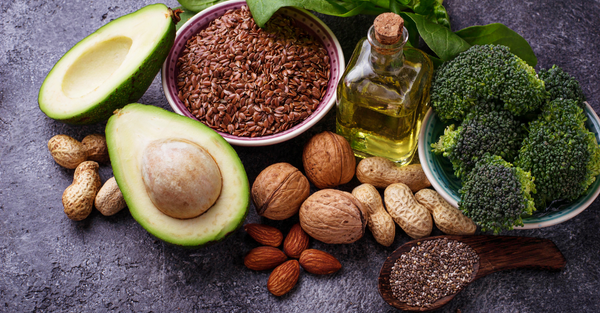Macros is a shortened term used for macronutrients, which are the major nutrient groups our bodies need to survive. They have become popular among fitness gurus, trainers and healthy folks alike because, once you get the hang of it, learning how to divide your food into macronutrients can help you leave calorie counting behind.
Macros are divided into three categories: carbohydrates, proteins and fats. Counting macros has become a popular trend and used as a way to control calorie intake as well as determining the best diet for health goals.
Learning to count macronutrients will take a slight learning curve. You first have to determine the ideal calorie intake for your goals, and then decide on the proper macro ratio that fits. The following are some nutrient ratios for certain diets, arranged by caloric ratios of carbs/fats/proteins percentages:
· Average healthy diet: 40% carbs / 30% protein / 30% fats
· Weight loss diet: 35/30/35
· Low carb diet: 10/40/50
· Keto diet: 5/20/75
Keep in mind these are averages and when embarking on any of these nutritional programs, one should consult with a nutrition expert and find the ratios that best suit your needs. If you want to eventually break free of counting calories, learning the nutritional importance of each macronutrient will help you narrow down a ratio for your goals.
Carbs – 4 calories per gram
Carbs, short for carbohydrates, are the main source of energy for your body. There are three types of carbohydrates which are sugars, starches and fibers. Sugars are converted quickly into glucose, your body’s fuel, starches are a source of nutrition and soluble fibers, and fibers are insoluble, which are not absorbed nor used as energy, but instead keep your digestive system clean and healthy.
Unhealthy carbs include foods that contain simple sugars and are mostly foods that are considered junk foods, or empty calorie foods. These include candy, pies, cakes, syrups, sodas and sometimes fruit juice and sports drinks. These should be either eliminated or extremely restricted in healthy diets.
Healthy carbs might be complex carbs and some foods that are considered simple carbs. Complex carbs take time for the body to digest and provide nutritional value and fiber. These may include whole, unprocessed grains, vegetables, and some whole grain breads. Some healthy foods contain simple carbs, but also contain fiber, which slows the absorption of glucose (or sugar) into the bloodstream. Starchy vegetables like potatoes and corn are considered complex carbs, but should be somewhat limited due to the high carb content.
Proteins – 4 calories per gram
Proteins are chains of amino acids and used in nearly every organ, tissue and bodily function, therefore high-quality protein is essential for good health. Your body is able to store protein, which may become a source of fuel for your body if needed. Proteins may be complete, incomplete or complementary, but most experts agree that if you consume a well-rounded variety of protein your body will get all the amino acids it needs.
Healthy proteins can be found in both animal and plant sources. Animal sources include poultry, beef, fish, eggs and cheese, while vegetable sources include tempeh, soy, beans, legumes and some grains.
Fats – 10 calories per gram
Fats were mistakenly given a bad rap for many years, but now we know better. Healthy fats contribute to healthy brain function, organ protection, nutrient absorption and even weight management. Unhealthy fats, on the other hand, can lead to obesity and heart disease if consumed in excess.
Saturated fats are the unhealthiest and are found in fatty beef, lard, cream and cheese, therefore should be limited. Trans fats are also unhealthy and can lead to heart disease among other things, and are found in fried foods and sometimes margarine. Most unhealthy fats are solid, or semi-solid, at room temperature. Unsaturated fats are typically liquid at room temperature and may be considered healthy.
healthy fats

Healthy fats are mainly unsaturated and come from plant sources. Some healthy fats are olive oil, canola oil and those in avocados and almonds. Omega-3 fatty acids are nutrition for your brain, among other things, and are found mainly in seafood like salmon, mackerel, herring, oysters and cod liver oil. Omega-6 is another healthy fatty acid that can support your immune system and weight loss.
The main source of this fat is grass fed beef or the butter and milk from grass fed cows, as well as avocados, almonds, hemp seeds, sesame seeds and pine nuts.
So How do I Count Them?
Once you decide on your total daily caloric intake, break it down into percentages. For example, based on an average healthy diet of 2,000 calories, the calories should be divided into 40% carbs, 30% protein and 30% fat, so here’s how it works:
· Carbs = 4 calories per gram, and 40% of 2000 calories is 800 calories of carbs per day (or 200 grams)
· Protein = 4 calories per gram, and 30% of 2,000 calories is 600 calories of protein per day (or 150 grams)
· Fats = 10 calories per gram, and 30% of 2,000 calories is 600 calories of fat per day (or 67 grams)
The above includes grams per calorie for those who want to prefer to measure how many grams of each food are needed. One thing to note is that you do not have to be precise in your calculations unless you have a specific health goal. And once you figure out your daily caloric goals and break it down into the calorie or gram ratios, you can follow that each day and it soon becomes easier to determine your food portions.
If the above process is overwhelming because you hate math, we get it. Many people use nutrition apps to keep track of their portions. These often contain a large database of foods that makes macro tracking easy. And if you don’t have access to an app, just use your hands.
Hand measuring is preferred by some people because they believe the portions will be relative to their ideal macronutrient balance, according to their size. Here’s how it’s done:
· Carbs should be about a serving, which is one cup, and maybe less if your goal is weight loss. This is about the size of an average woman’s fist (men will have to use their imagination).
· Protein portions should be about the size of the palm of your hand, which should equate to roughly 3 grams, more for larger people. A fish fillet should be the length from your fingertips to your wrist.
· Fat portions should be roughly the size of your thumb nail and health fats should be a nutritional goal for good health.
Each of these measuring techniques works, and which you use depends on how precise you need to be. Many people begin with the easy hand measuring method and get more precise as they refine health goals. Just be sure your macro choices are healthy ones, and counting will soon become second nature.
Happy eating!



